Visiting Greece: My Best Tips for Enjoying an Artsy Trip
This page may contain affiliate links to products or services I’m happy to recommend. If you click on an affiliate link and then make a purchase, Artsy Traveler may earn a small commission at no cost to you. Thank you!
Visiting Greece is a must-do for the Artsy Traveler. As the birthplace of western culture, Greece has a wealth of fascinating history–from Minoans to Myceneans to Spartans to Athenians. You can’t go far without stumbling across ancient ruins in Greece.
In addition to great museums showcasing Greece’s rich history, you’ll find artisans, galleries, music, and of course amazing food. I consider sampling local cuisines as a vital component of any artsy traveler’s experience! And Greece has some of the best and freshest food I’ve ever eaten.
So far, my travels to Greece have included two islands (Santorini and Naxos), along with Nafplio, iconic ancient sites such as Epidaurus, Mycenae, and Delphi, stunning Meteora, and Athens. There’s lots more to explore, and I look forward to many more trips.

On this page, I include my posts about Greece and also list some of the highlights of this wonderful country.
Posts About Visiting Greece
Here are my posts about Greece to give you ideas about what to see and do.

Nine Great Reasons To Visit Meteora in Greece
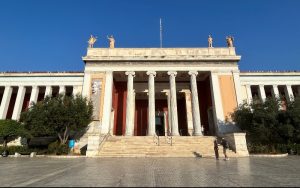
What to See at the National Archaeological Museum in Athens

How to Spend a Perfect Artsy Traveler Day in Athens

Should You Make the Climb to the Acropolis of Athens?
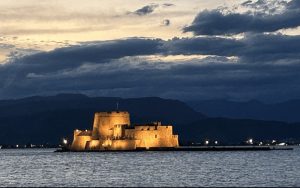
How To Spend Two Wonderful Days in Charming Nafplio in Greece

Explore Greek Cuisine in a Savor Nafplio Cooking Class

How to Spend Two Laid-Back, Glorious Days on the Greek Island of Naxos

Stay in Oia to Enjoy a Stunning Santorini Experience
Highlights of Visiting Greece
From an Artsy Traveler perspective, here are a few highlights to explore if you’re traveling around Greece. The map below gets you oriented.
Santorini
Santorini (#1) in the Cyclades Islands is an iconic destination that makes it on to most people’s bucket lists. And rightly so. The views from the clifftops are beyond spectacular. Even the locals I spoke with declared they never tired of the view. And no wonder! But with Santorini’s iconic status comes crowds–a LOT of crowds. On my first full day on Santorini, five cruise ships were in port. I have no idea how all the passengers made it up the cable car from the old port to Fira. I’m guessing the town was nightmarishly crowded. That day, I lay low, mostly basking by the pool at Aethrio Sunset Resort.
If you haven’t visited Santorini, go! It’s worth seeing, and you can somewhat the crowds by staying in charming Oia rather than over-crowded Fira. Check out my post for more about why Oia is your best bet: Stay in Oia for a Stunning Santorini Experience.
Naxos
Laid-back Naxos (#2) with its sparkling beaches and rugged interior feels like the quintessentially Greek island. It makes a marked contrast from Santorini, and of the two is my favorite. Go there to relax and recharge, and to enjoy the best food I ate in Greece (which is saying something).
Check out my post for more about Naxos: How to Spend Two Laid-Back, Glorious Days on the Greek Island of Naxos
Nafplio
This charming town on the edge of the Peloponnese Peninsula is still relatively undiscovered. It’s a delightful place to spend a few nights. It’s also the perfect home base for exploring some of Greece’s most famous ancient sites, including Corinth, Epidaurus (home of the amazing ancient theater) and Mycenae. I really liked staying in Nafplio (#3) and would have liked to stay longer to enjoy some of the beaches and more drives into the countryside.
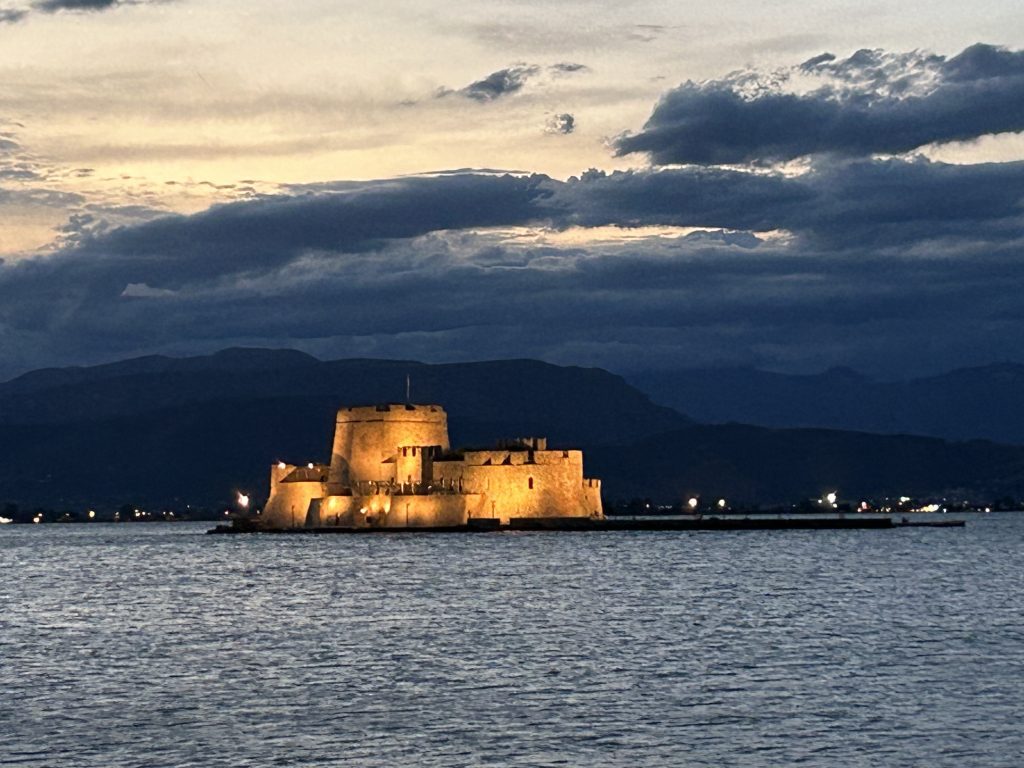
Meteora
Central Greece includes one of the world’s most amazing destinations. Meteora has thoroughly discovered with plenty of tour buses making the trek from Athens and elsewhere, but nothing can take away from the splendour of the views and its fascinating. At one time, 24 monasteries perched on the dizzyling steep rock formations. Now there are just six and they are pretty much over-run with visitors.
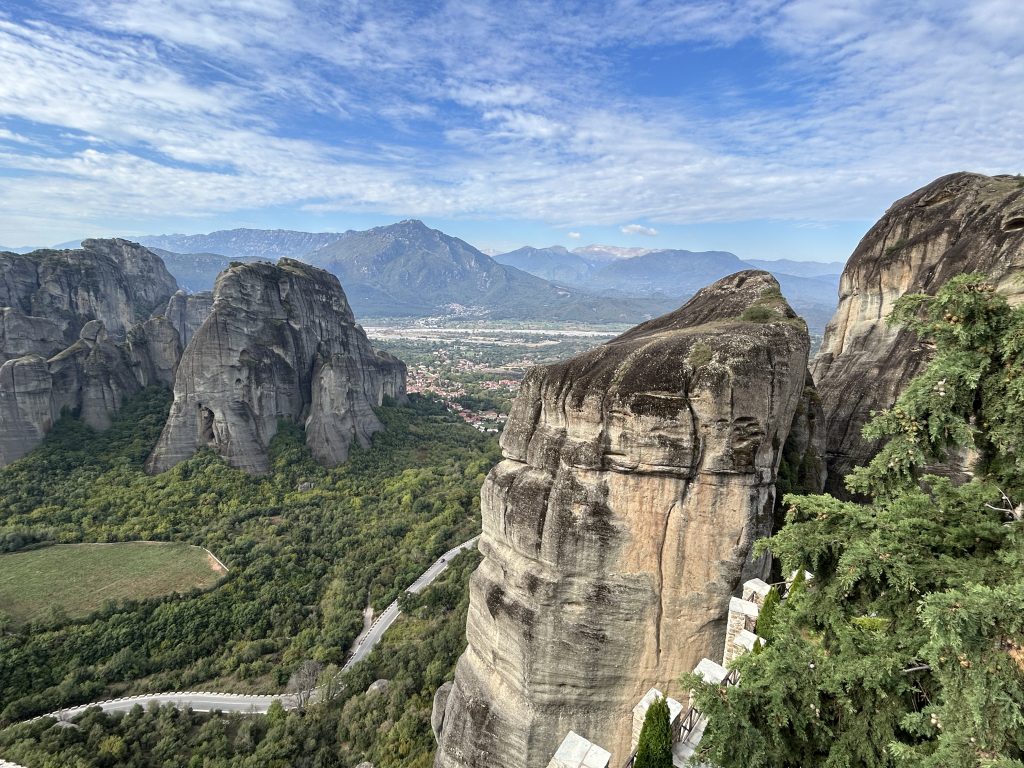
It takes a bit of organizing to get to Meteora (#4), but the journey is worth it. You’ll experience a region that feels straight out of a fairytale.
Delphi
Home of the oracle of ancient times, Delphi (#5) and its adjourning archeological site is worth a visit. The town is small and charming with cute restaurants and spectacular views, while the archeological site is spine tingling. Make sure you wear sturdy walking shoes to explore the ruins. Most of the time, you’ll be climbing.
Athens
I expected a big, noisy, smelly, ugly city. I discovered a chic, and pleasant central area awash with visitors and yet still extremely charming. Outside of this area, Athens sprawls, but you’re not likely to spend much time outside the central area.
What I didn’t realize is how much the Acropolis with its ancient temples dominates the Athens cityscape. Everywhere you go, you glimpse it floating high above the city, illuminated by night and gleaming white by day. Find out if you should make the climb up to see the Acropolis.
All around the Acropolis are more ruins, plenty of trees, lots of winding streets, souvenir stores in the touristy Plaka area, and posh shops in Kolonaki. Check out the changing of the guards, visit the Acropolis Museum and the Archaeological Museum of Athens, buy souvenirs, and enjoy the velvety warm night air.
Here are my suggestions for the Perfect Artsy Traveler Day in Athens.
Practical Tips for Visiting Greece
This page covers some of the basics of visiting Greece–when to visit, checking events, transportation (including how to get there), accommodations, and food.
Decide When to Visit
First off, decide when you want to visit Greece. If you are hoping to avoid the worst of the crowds and the hottest weather, choose the shoulder seasons–April and May or September and October. You can travel around mainland Greece in the winter, but you may want to avoid the islands when most hotels and restaurants close for the season and the weather can be blustery.
I visited Greece in September and the weather was perfect for touring, with temperatures averaging around 25 degrees with clear skies. I almost never needed a sweater, even in the evenings.
Check Events and Exhibitions
Before you visit Greece, check online for exhibitions and performances. Also be on the lookout for local festivals.
You’ll definitely want to check what concerts are on while you’re in Athens. If you’re lucky, you’ll catch a performance at the Athens Herodes Atticus theater, one of the best places to experience a live classical theater performance. The ancient theater was built by the Romans in 161 AD. Fortunately, the seats have been upgraded to accommodate modern bottoms.
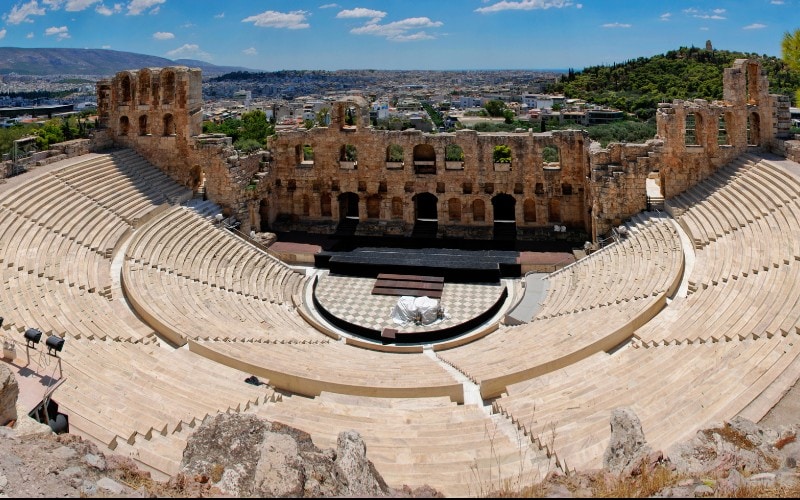
Another option in Athens is the folk dancing concert at the outdoor Dora Stratou Theater located in a park setting on Philopappou Hill opposite the Acropolis. Dancers, musicians and folk singers clad in authentic costumes and wearing traditional jewelery showcase the traditional dances from all over Greece and the islands.
Warning: If you go in late September, take a warm sweater to ward off the evening chill.
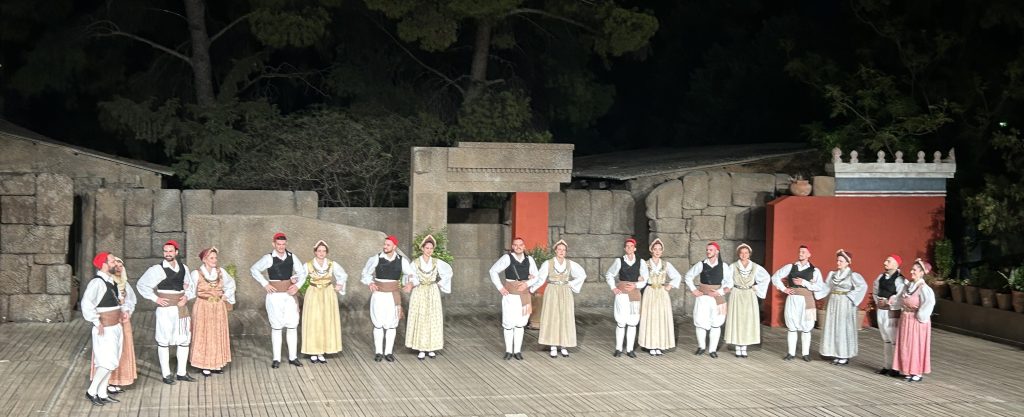
Choose Your Transportation
Greece is a large country that includes many, many islands. To get around, you can either rent a car or choose a combination of tours, private transfers, and buses for the mainland, and ferries or flying for the islands.
On my recent trip to Greece, I chose not to rent a car, and I’m very glad I made that decision. While the highways are relatively traffic free and appeared easy to drive, the smaller, more scenic roads looked pretty danged treacherous to me. Many times during the trip I commented how pleased I was that I hadn’t rented a car, particularly on the islands where just about every road is narrow and some hug the sides of cliffs a bit too precipitously for my comfort. Traveling in a bus or car driven by someone else was hair raising enough.
When I add up the cost of private transfers, buses, day tours, and ferry fares, I’m pretty sure the total cost isn’t that much more (and may even be less) then renting a car for the duration of the trip. Factor in parking, insurance, gas (expensive in Greece as elsewhere in Europe), and not to mention stress, and I’m pretty sure I got the better end of the bargain.
Private Transfers
I’m particularly fond of private transfers and book them whenever I can when the price is within my budget. When we arrived in Piraeus, the port of Athens, off the ferry from Naxos, I was relieved to see amid the massive crowds a man holding up a sign with my name on it. Within minutes of trundling off the ferry with our luggage, we were installed in an air conditioned car and being whisked westwards to Nafplio–a two hour drive. The alternative to a private transfer would have been a long, hot journey on public transit into Athens to then transfer to a bus for the journey to Nafplio. The journey would have taken twice as long, but yes, it would have cost less.
Public Buses
I took public buses a few times on Santorini and for the transfer from Delphi to Athens. In Greece, public buses are large tour buses with comfortable seats and air conditioning. On the trip from Delphi to Athens, the bus stopped once at a roadside restaurant to give passengers a chance to stretch their legs and use the facilities. The only drawback with buses in my experience is they sometimes don’t run on time (the bus from Delphi to Athens was a good 45 minutes late), and they go along back roads rather than highways, and are therefore slow.
But they are cheap!
Ferries
If you visit more than one island in Greece, you’re very likely to take a ferry at least once. Several ferry companies offer services throughout the islands on fast, medium, and slow ferries. Several weeks or even months before you travel, book your ferry travel with Ferry Hopper. You’ll download online tickets that are scanned when you board. It couldn’t be easier!
Fights
You can fly to Athens from most major cities in Europe and even some direct flights from the US and Canada. You can also fly to several of the islands. I flew from London direct to Santorini–a four-hour flight. Upon arrival, I was picked up at the airport by a private transfer I’d arranged through my accommodation. The convenience of getting picked up and taken directly to my hotel was well worth the 45 euro cost. The alternative would have been two buses–one from the airport to Fira and then from Fira to Oia.
The airport in Athens is large and easy to navigate. I took a taxi from our hotel in Athens directly to the airport at a cost of 46 euros.
Book Guided Tours
I booked several small group tours in Greece, and all of them were worthwhile. I was able to go places in comfort that I would never have found on my own. Some of the roads, particularly on the islands, are very steep and narrow. I was more than happy to leave the driving to the guide. To find tours from half-day to multi-day, check websites such as GetYourGuide. Here are some options available.
Staying in Greece
Each place I stayed in Greece was comfortable and reasonably priced, apart from Santorini, where the accommodation was excellent but the price high. But that’s Santorini, and it’s best not to judge the rest of the country by its inflated prices.
Here are the places we stayed in Greece, with a short description about each. I happily recommend all of them.
Oia on Santorini
We stayed at the Aethrio Sunset Village, which was wonderfully located and good value. If you’re going to Santorini, I suggest staying in Oia rather than Fira, which is more central but also a lot more crowded. For more about Santorini, Oia and Aethrio Sunset Village, check out my post: Stay in Oia for a Stunning Santorini Experience.
Naxos
On Naxos, we stayed for three nights at the very well-appointed and spectacularly located Kalergis Studios. For a third of the price of our hotel in Santorini, we had a large room with a kitchen and a view of the beach. The staff are very helpful (even did our laundry for a nominal fee) and the studios are right above the Yannis Bar that serves wonderful food all day long and manages a fleet of sunbeds on the beach.
Nafplio
Of all the places we stayed in Greece, the apartment in Nafplio called 99 Dream Vacations was the best. It was HUGE, very centrally located on a pedestrian only street, and extremely comfortable. The fridge and cupboards were even well stocked with the basics, including yogurt, eggs, and coffee.
Here are photos of the living room and dining room at 99 Dream Vacations.


Athens
I stayed in two places in Athens–for two nights in the middle of the trip and for one night at the end. The first place was Karma Athens, a self-catering apartment smack in the middle of the Plaka neighborhood and within sight of the Acropolis. In fact, the rooftop terrace had a partial view of the Acropolis, which looks particularly fetching when floodlit at night. The apartment was spacious and well-equipped. The location, within walking distance of most places you’d want to go in Athens, can’t be beat.
At the end of the trip, I stayed in the Hotel Lozenge in the upscale Kolonaki district of Athens. The Lozenge is a stylish business hotel and perfect for the last night of the trip.
Meteora
The Theatro Hotel Odysseon in the charming town of Kalabaka overlooks some of the towering rock formations that have made the Meteora region famous. The room with a balcony was comfortable, the breakfast tasty, and the pool refreshing (aka, a bit on the chilly side!). And the view!
Delphi
We stayed just one night at the Kastalia Hotel in Delphi, located on the one main street of the town and an easy fifteen minute walk to the ruins at Delphi. The terrace at the hotel was enormous with a spectacular view over the valleys and mountains of this rugged area of Greece. The staff were particularly friendly.
Click on the map below to find places to stay in Greece.
Eating in Greece
One word describes the food in Greece and that word is fresh. Every tomato tastes like it was picked that morning; the olive oil is fragrant and flavorful, the meat is succulent and wonderfully seasoned, the slabs of feta cheese are large, creamy, salty and all round delicious… I could go on. Suffice it to say that the food in Greece is very, very good!
The one drawback is that there is not a lot of variety to the menus. Most have the same things–Greek salads, moussakas, souvlakis, fish dishes, pastas and other Greek stalwarts with the occasional hamburger and pizza thrown in for good measure. But in sixteen days in Greece, I never had a poor meal.
The prices are also reasonable. An average dinner for two with two main courses and a drink each usually cost around 40 euros, except in Santorini where the price soared to around 80 euros.
And at the end of most meals, the server brings a complimentary dessert and/or a glass of something strong and alcoholic.
A word about breakfasts! At every breakfast buffet and in every cafe we ate in for breakfast, Greek yorgurt with honey and fruit was on the menu. Greek yogurt in Greece is truly to die for, and the fruit was fresh and tasty.

More Tours and Tickets in Greece
Conclusion
Have you traveled to Greece? Share your experiences and recommendations with other Artsy Travelers in the Comments below.
Here are posts to read next to help you plan your Greece trip:
- Stay in Oia for a Stunning Santorini Experience
- How to Spend Two Laid-Back, Glorious Days on the Greek Island of Naxos
- Nine Great Reasons To Visit Meteora in Greece
- How to Spend a Perfect Artsy Traveler Day in Athens
- Explore Greek Cuisine in a Savor Nafplio Cooking Class
- How To Spend Two Wonderful Days in Charming Nafplio in Greece
- Should You Make the Climb to the Acropolis of Athens?
- National Archaelogical Museum of Naples
